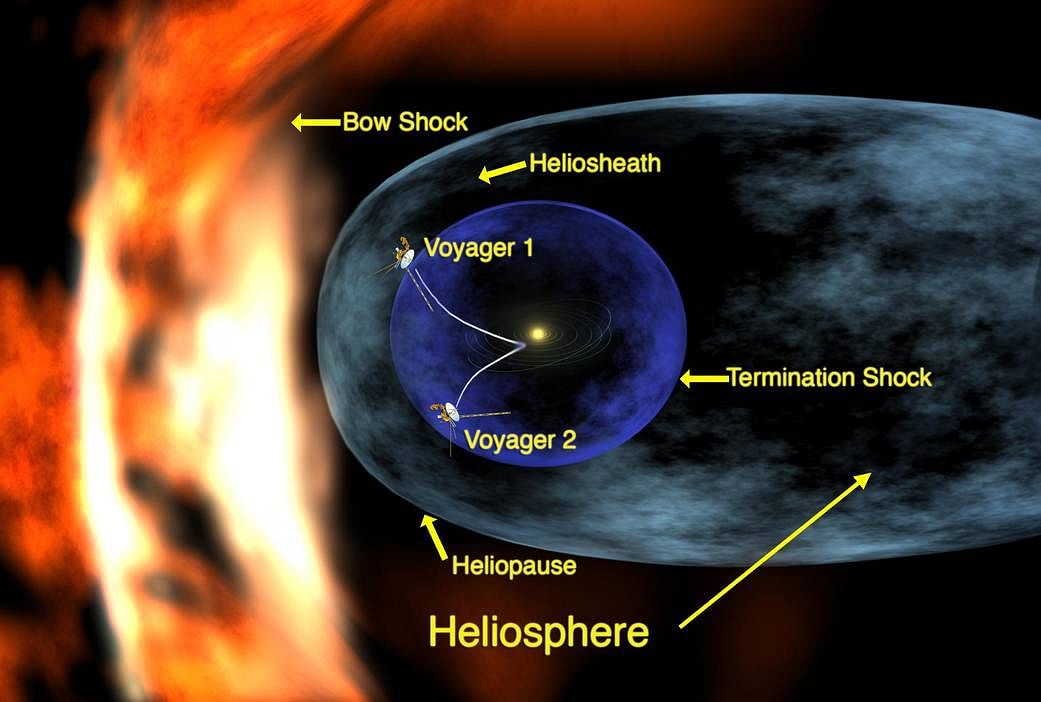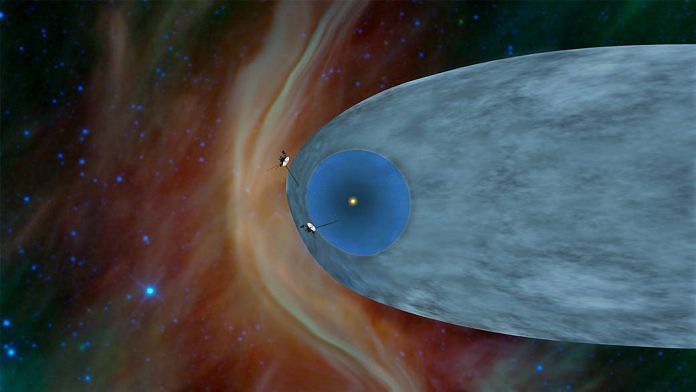Bengaluru: A year after Voyager 2 became only the second human-made object to enter interstellar space, astronomers have shared insights from the feat in five papers published in Nature Astronomy Monday.
Voyager 2 is the second spacecraft after its twin, Voyager 1, to cross the heliosphere, a protective bubble of speeding charged particles flying outwards from the sun. Both were launched in 1977.
It is the first time that astronomers have been able to actually study the electrically-charged, superheated particles, called plasma, at the very edge of the boundary of this heliosphere, where charged particles from the sun and matter from interstellar space start to collide.
The results also highlight the difference between the observed readings about the structure of the different layers of the solar boundary made by Voyager 1 and Voyager 2.
The papers show that this outer boundary is not uniform, and both the spacecraft encountered different electromagnetic phenomena on their way out.
The findings demonstrate that humans are only beginning to understand what happens at the far reaches of the solar system we inhabit.
Solar system’s outermost boundary
As the sun speeds through the galaxy, dragging the solar system with it as it orbits the galactic centre, it provides a comet-like shape to the heliosphere.

The matter that presses against the heliosphere is called the ‘interstellar medium’ or ISM. It is made up of gas and dust formed by the millions of supernovae and other violent phenomena in the galaxy.
The solar wind presses outwards against the ISM, maintaining a pressure balance. But the transition from the heliosphere into interstellar space, which both Voyagers performed, does not happen in an instant. Instead, there are phases of mixing of matter between the two, causing turbulence in space.
The outermost boundary that the Voyagers crossed is called the heliopause. Beyond this is interstellar space, where there are no solar particles. Instead, the ISM makes up the primary material.
“We are trying to understand the nature of that boundary, where these two winds collide and mix,” said Ed Stone, physicist at the California Institute of Technology and project scientist, during a press briefing. “How do they mix, and how much spillage is there from inside to outside the bubble, and from outside the bubble to inside?”
Voyager 1 crossed the heliopause on 25 August 2012, while Voyager 2 did so on 5 November 2018.
Also read: An asteroid orbiting between Mars and Jupiter could be a new dwarf planet
Voyager 1 vs Voyager 2’s findings
The planets in the solar system orbit on the ecliptic plane. Voyager 1 exited the heliopause in a direction north to the plane, and Voyager 2, south.
Both spacecraft encountered similar signs of the approaching heliopause — there was a sudden increase in cosmic rays coming from outside the heliosphere, and the raging solar wind slowed down from supersonic to near-zero speeds at about 8 AU (just short of the distance between the sun and Saturn) before heliopause crossing.
Both Voyagers experienced a nearly 50-fold increase in the density of magnetic plasma after crossing the heliopause.
But the similarities between Voyager 1 and Voyager 2’s exits end here.
Astronomers discovered that, astoundingly, Voyager 2 could cross the entire transitionary boundary in less than a day. This was unexpected, especially given that the lack of plasma data from Voyager 1 meant the moment of transition couldn’t be pinpointed.
“The plasma data helps pin down the time when we left the outward flowing solar wind,” said John Richardson of Massachusetts Institute of Technology, who is the principal investigator of the plasma instrument, to ThePrint. “Voyager 1 did not have a working plasma instrument so we were never sure quite when the crossing occurred.”
The team also noted something unusual. Just before transitioning through the heliopause, Voyager 2 actually encountered a thick boundary region equal to the distance between the sun and Mars. Here, the slowing plasma heated up to twice the normal temperature expected in the region, to nearly 50,000 degrees Celsius.
The magnetic field was also much stronger here and it influenced the entry of cosmic rays from interstellar space into the heliosphere. This magnetic barrier was not observed when Voyager 1 crossed the heliopause, suggesting that the outer boundary of the heliosphere is not all that uniform.
Astronomers also found that the speeds and intensities with which magnetic fields vary and cosmic rays enter the heliosphere varied at the two exit regions.
Earlier, Voyager 1 had detected two “tubes” or waves of increased cosmic rays from the ISM before it was able to cross the heliopause. These were not observed with Voyager 2, which had a smoother transition through a “thinner and simpler” heliopause.
Exploratory knowledge
The comparison of crossings of Voyager 2 and Voyager 1 helps us understand what happens at the edge of the sun’s protective bubble and how the physics of plasma — the fourth state of matter after solid, liquid, and gas — shapes up here.
The heliopause is still not the end of the solar system. The region beyond this continues to be under the influence of the sun’s gravity, with several bodies orbiting the sun as well.
Voyager 2 crossed the heliopause at 119 AU (where 1 AU is the average distance between the Earth and the sun, approximately 14.96 crore km) and Voyager-1 at a different location at 121 AU, but the solar system extends up to 200,000 AU. For scale, Neptune orbits at approximately 30 AU.
The two Voyagers will soon encounter the ‘bow shock’, a shock wave formed ahead of the heliosphere as the entire structure moves through interstellar space, similar to the wave formed in front of a ship that plows through the ocean. And scientists don’t know what to expect next or what they would find.
Crossing the heliopause tells scientists a lot about the nature of the solar wind, the influence of the sun, and the extreme physics that govern these less-understood regions of far space.
The results themselves show that we’ve just started making progress in human understanding of dynamic processes that take place in the system because of the sun. But we have barely scratched the surface and need to find more ways of learning more.
NASA’s New Horizons mission, which flew by Pluto, will be a likely source of more information from a much closer location, with other missions planned for the future as well.
“NASA is also studying a possible interstellar probe mission which would move outward much faster than the Voyagers and go much farther than the Voyagers,” said Richardson.
Also read: NASA unveils new spacesuits for astronauts for 2024 Moon mission



